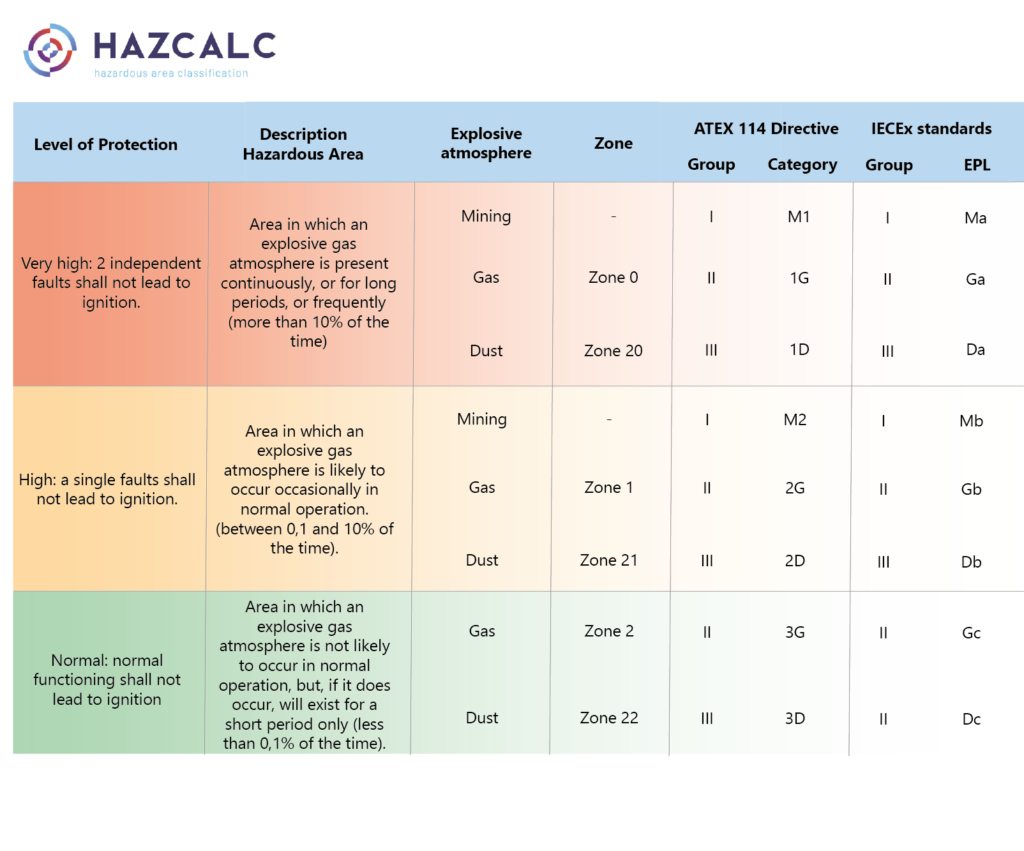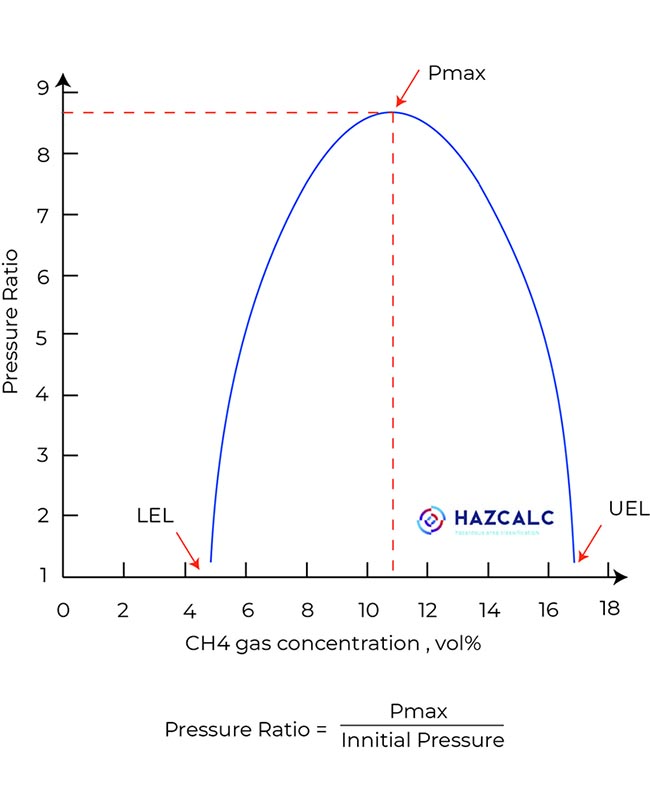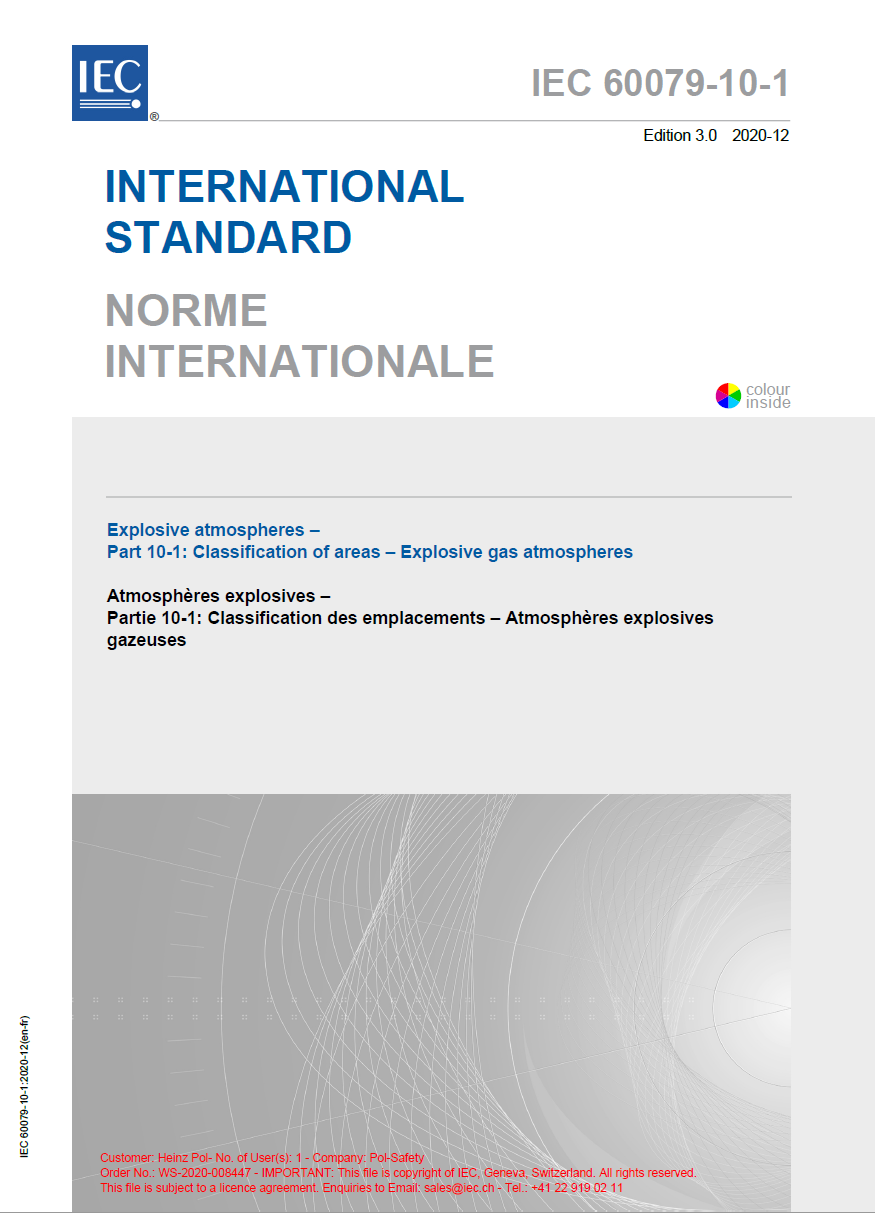What is Hazardous Area Classification?
Hazardous Area Classification is a study, in which is assessed, at witch locations of a plant, factory or company, high concentrations of flammable gases are present or can be released, in order to create an explosion hazard.
Therefor Hazardous Area Classification (HAC) is the first important step in achieving an explosion safe installation or work environment. One of the hazards of working with flammable substances is an explosion, mostly hand in hand with fire.
Numbers of Explosions
Figures show that appr. 41 gas explosions per year occur within the UK and app. 286 natural gas explosions per year in the U.S. causing substantial damage, severe injury or loss of lives.
So it is quite obvious that explosions should be prevented as much as possible and still work has to be done to achieve this. The prevention of explosions in working environments is in most countries regulated in national laws and directives. For example, within the U.K. in the Dangerous Substances and Explosive Atmospheres Regulations 2002 (DSEAR) and in the U.S. in the Occupational Safety and Health Act of 1970 (OSHA).
In order to understand hazardous area classification it is important to understand which factors contribute to the occurrence of an explosion. The following content is only related to flammable substances and not to pyrotechnic substances or other instable substances, among those who can decompose.
Explosion Triangle
An explosion is a rapid expansion in volume associated with an extremely vigorous outward release of energy, usually with the generation of high temperatures and release of high-pressure gases (wikipedia (https://en.wikipedia.org/wiki/Explosion).
This rapid expansion of volume is caused by the combustion of a fuel, like e.g. ethanol, methane or hydrogen. So for an explosion there must be enough fuel. Since this fuel can only combust in the presence of oxygen, enough oxygen must be available for the rapid combustion to take place.
The last requirement for the explosion is the presence of an ignition source, like a spark or hot surface.
So the following conditions must be met for an explosion to occur:
- Presence of sufficient fuel
- Presence of sufficient oxygen
- Presence of an effective ignition source
Represented by the following explosion triangle.

Lower Explosion Limit
Substance properties are specific for the amount of fuel needed to get an explosion when all other conditions are met. This is presented by the Lower Explosion Limit (LEL) of a substance. The lower explosion limit of a substance is “the lowest concentration (in volume percentages for gases and liquids) of a gas or a vapor in air of producing a flash of fire in the presence of an ignition source”.
When the concentration of gas or vapor is beneath the LEL the gas mixture is “too lean“ to burn. Methane has a LEL of 4,4 vol%. When the concentration of methane is beneath the LEL, an explosion cannot occur, even when an ignition source is present.
Upper Explosion Limit
Beside the Lower Explosion Limit, each substance also has an Upper Explosion Limit (UEL). The upper explosion limit of a substance is “the highest concentration (in volume percentages for gases and liquids) of a gas or a vapor in air capable of producing a flash of fire in the presence of an ignition source”.
When the concentration of gas or vapor is above the UEL the gas mixture is “too rich” to burn. Methane has a UEL of 17 vol%, which means when the concentration of methane in air is above the 17 vol% an explosion cannot occur even when an ignition source is present.
So the flammable range of a substance is the concentration of gases and vapors in air between the Lower Explosion Limit and the Upper Explosion Limit.

Oxygen Concentration
Beside sufficient fuel, also sufficient oxygen is needed for combustion of the mixture. The minimum concentration of oxygen, necessary for the combustion to take place, is called the Limiting Oxygen Concentration. This is exactly defined as the limiting concentration of oxygen below which combustion is not possible, independent of the concentration of fuel. The value is represented is volume percentage of oxygen. This value of this LOC differs per substance and depends also on the inert gas for achieving a low oxygen concentration.
Blanketing
In ambient conditions it is assured that oxygen is always present and thus not a factor that has to be incorporated within the hazardous area assessment. For non-ambient conditions, like process reactors or other enclosed systems, the Limiting Oxygen Concentration is often used for the prevention of explosive atmospheres within those enclosed area’s. This can be achieved by blanketing with nitrogen or carbondioxide.
Classification af Area's
As mentioned, the first important step of achieving a safe work environment in relation to explosion safety is to identify and classify those area’s, where a concentration of flammable gases or vapors within the flammable range can be present. This process is called hazardous area classification. This is also one of the first steps when composing an Explosion Protection Document.
Area's are divided into zones. For explosion hazards caused by flammable liquids or gases, the following zones are defined:
| Zone | Description |
| Zone 0 | area in which an explosive gas atmosphere is present continuously, or for long periods, or frequently (more than 10% of the time). |
| Zone 1 | area in which an explosive gas atmosphere is likely to occur occasionally in normal operation. (between 0,1 and 10% of the time). |
| Zone 2 | area in which an explosive gas atmosphere is not likely to occur in normal operation, but, if it does occur, will exist for a short period only (less than 0,1% of the time) |
So a zone 0 is the most hazardous zone and a zone 2 is a less hazardous zone. Area which are not devided into Atex zones, are called non-hazardous area's.
Class / Division System
In Northerm America, instead of the zone classification system, the Class/Division system is used.
The relation between that system and de zone classification system is clarified within the following table (only for gases and liquids are displayed, not for dusts and fibers).
| Class | Division | Zone |
| Class I | Div I | Zone 0 |
| Class I | Div 1 | Zone 1 |
| Class I | Div 2 | Zone 2 |
The use of equipment in hazardous areas
Equipment used in hazardous area must comply to certain Ex standards. In Europe the ATEX 114 Directive (2014/34/EU) is applicable to equipment that is used in hazardous area's. The more hazardous the area to more safety measures have to be taken in order to prevent equipment becoming an effective source of ignition. The following Equipment Groups and Categories are applicable:

ATEX Equipment Groups
ATEX equipment group I:
Equipment in this category is only intended for use in the underground areas of mines, as well as those areas of surface installations of such mines endangered by firedamp and/or combustible dusts.
ATEX equipment group II:
Equipment in this category is intended for use in areas in which explosive atmospheres caused by gases, vapours, mists or air/dust mixtures are likely to occur occasionally. Examples are: production facilities in the food industry, chemical plants, oil & gas, and the pharmaceutical industry etc.
Equipment category 1
Equipment in this category is intended for use in Zone 0 areas (gases) or Zone 20 (dusts), and must ensure a very high level of protection (i.e. the inside of tank truck or the interior of a dust filter). The design of the equipment must ensure protection, even in the event of rare incidents relating to the equipment. And safety must be guaranteed in the case of two faults occurring independently of each other.
Equipment category 2
This equipment is intended for use in Zone 1 (gases) or Zone 21 (dusts). A high level of protection is ensured. You will find these zones at the manifold of a tank truck or the interior of a silo. Safety is ensured in the event of frequently occurring disturbances or equipment faults which normally have to be taken into account.
Equipment category 3
Is intended for us in Zone 2 (gases) or Zone 22 (dusts). Explosion protection must be ensured during normal operation. You will find this equipment in paint factories, a warehouse or around a bag dump station. Ways to ensure this level of safety are non-arcing design and limitation of the temperature of the equipment.
Effects of an Explosion
It is good to be aware of the fact that the mixture of flammable gas with oxygen has an optimum point where the combustion is most severe and leads to the highest explosion pressure. This concentration is substance specific and lies normally somewhere between the LEL and UEL. For methane this is shown in the following figure.
So, it is good to know that when a flammable substance concentration exceeds the LEL, it will not automatically lead to an explosion with the highest Pmax. But when we take a closer look at the graph and table, we can conclude that any explosion, can easily lead to severe damage.

Effects of an explosion on objects or persons
| Overpressure [mbar] | Effects on objects and persons |
| 1-3 | Slight damage to glass panels |
| 10-15 | Threshold for glass breakage |
| 15-25 | Lower limit for damage from debris |
| 35-75 | Window breakage, cracks plaster, light damage to buildings |
| 70-100 | Persons blown over |
| 75-125 | Deformation of thin metal sheets |
| 75-150 | Collapse of wood or asbestos siding of homes |
| 125-200 | Collapse of walls made of concrete blocks |
| 200-300 | Collapse of self-supporting buildings |
| 200-300 | Cracking of oil tanks |
| 300-500 | Demolition of support poles |
| 300-500 | Severe damage to steel-framed buildings |
| 350 | Lower limit for eardrum fracture |
| 400-600 | Reinforced concrete structures severely damaged |
| 400-600 | Trains blown over |
| 700-800 | Total destruction of unarmed buildings |
| 2000-5000 | Lung damage |
| 7000-15000 | Letal |
Ignition Sources
The last condition for an explosion is the presence of an effective ignition source in the direct contact with the fuel/air mixture. Within a working area or installation an ignition can be created by many factors. Ignition sources can be divided in 13 categories (acc. to EN 1127-1):
- Hot surfaces
- Flames and hot gases (including hot particles)
- Mechanically generated impact, friction and abrasion
- Electrical equipment and components
- Stray electric currents, cathodic corrosion protection
- Static electricity
- Lightning
- Radio frequency (RF) electromagnetic waves from 104 Hz to 3 × 1011 Hz
- Electromagnetic waves from 3 × 1011 Hz to 3 × 1015 Hz
- Ionizing radiation
- Ultrasonic waves
- Adiabatic compression and shock waves
- Exothermic reactions, including self-ignition of dusts
Use of Ex equipment in Ex-zones
After the hazard area classification is completed, then the ignition assessment starts. Wide known is that al electrical equipment within hazardous areas must be Ex certified for use in the appropriate hazardous area (zone or class/division). This means that the electrical equipment is safe for use within these area by applying special protection strategies. These ways of protection are specified in detail within several IEC standards (IEC 60079 series) for electrical equipment. But beside electrical equipment also mechanical equipment must be Ex certified, e.g. according to ISO standard 80079 series.
Other ignition sources can also be present, like static electricity. We will go deeper into ignition assessments in another blog.
How to perform Hazardous Area Classification?

There are several ways of how to perform hazardous area classification, all described in several standards or codes of practise. Examples are:
- EI 15 – Energy Institute 15, mostly for on- and offshore oil and gas applications
- API 500/505 – mostly for onshore and offshore oil and gas applications.
- EN 16985 – concerning spray cabins and powder coating cabins
- EN 12779 – related to extraction systems for hot sawdust and chips
- EN 60079-10 series, 2020 version for gas and dust explosion hazard
- NPR 7910 series for gas and dust explosion hazard based on EN 60079-10-1, 2015 version
- EN 13617 for fuel dispensers at filling stations
- CECOD Guide for petrol stations (public)
- BGR 104 Beispielsamlung (public)
In another blog we, will explain how to perform Hazardous Area Classification according to the Standard EN-IEC 60079-10-1.
Which Standard to follow?
The most standards and codes of practise for Hazardous Area Classification describe typical installations and work environments and their hazardous areas. Some other standards have more quantitative methods which require more knowledge of the plant, an example is the IEC standard 60079-10-1.
The choice of which standard to use for the hazardous area classification is something which is very important. For specific industries, the specific codes for that industry are important to use.
For example the EI 15 and API 500/505 describe specific installations and several conditions for the oil and gas industry. It is obvious to use those standards within these industries. The disadvantage of standards with example installations, is that a huge safety factor is incorporated and thus relative large hazardous area are defined.
For more detailed assessments or for situations where no specific industry standards are available , like the chemical – or pharmaceutical sector and also specific installation for oil and gas industries, a more quantitative approach can be used. A more quantitative method is described in IEC 60079-10-1 but also more sophisticated numeric mathematical models can be used like Computational Fluid Dynamics.
With our experience we can conclude:
A quantitative model for Hazardous Area Classification gives more realistic and specific classifications for hazardous area's comparing to a direct example approuch!
So yes, it is important to choose the right model and always wonder “what am I assessing?”. It is always balancing between not defining such area’s too large (with highly costs for prevention of ignition sources) or too small (unsafe situations).
Read more in our blog “Which Standards to use for Hazardous Area Classification”.



